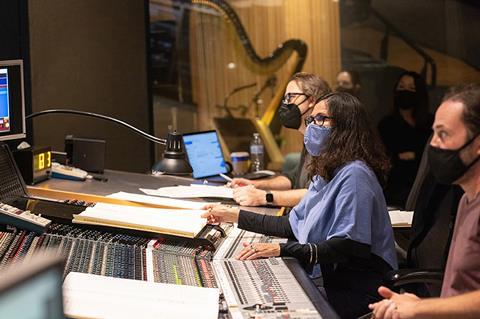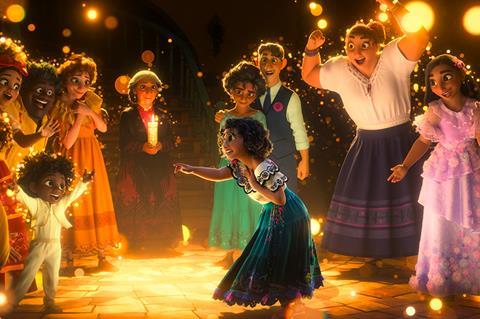Germaine Franco researched tirelessly to write the score for Disney Animation Studios’ Encanto. She tells Screen about the rich tapestry of Colombian music and culture that she drew on for inspiration.

Growing up in El Paso, Texas, on the US side of the southern border, Germaine Franco crossed into Mexico every week with her family to shop, go out to eat, and listen to music played by musicians peppering the streets of Ciudad Juarez.
“That was my first influence,” says the composer, who is Oscar-nominated for the first time in her 30-year career for scoring Disney Animation Studios’ Encanto, the story of Mirabel, a Colombian girl struggling to find her place in a big family as the only member without magical powers. Franco makes history as not only the first Latina, but the first woman of colour to be Oscar-nominated for an original score.
“I had a brother and two sisters, and we used to listen to music, and we had a piano that I started tinkling on when I was young,” recalls Franco. “We weren’t a musical family, but we were always encouraged to do creative things.”
Franco began taking lessons and joined her school band, where she fell in love with the drums. “I just got completely obsessed with [drumming],” she says. “My parents kept asking me, ‘Can’t you play the flute or the violin? The clarinet?’ And I said, ‘No, I’m playing the drums.’”
In addition to her many credits, such as Pixar’s Coco (for additional music, working alongside composer Michael Giacchino), Dora And The Lost City Of Gold, Little and animated TV series The Casagrandes, it is percussion that made Franco the perfect composer to score Encanto. In it she collaborates with the film’s songwriter and lyricist, Tony winner Lin-Manuel Miranda, whose ‘Dos Oruguitas’ sees his second original song Oscar nomination. The bold and energetic music of Encanto is full of rhythms that bring to life the philosophies and artistry of Colombian literature and music that Franco dedicated herself to in building the film’s score, especially as it pertains to magical realism.
“I got my Gabriel Garcia Marquez and Isabel Allende and read them in Spanish,” says Franco. “I got tons of books on Colombian history and listened [to its music], watched videos, documentaries from Indigenous [Colombians] all the way from the 1500s to now.”
The film’s writer/director Jared Bush, director Byron Howard and co-director/writer Charise Castro Smith gave Franco the guidelines: infuse the score with traditional Colombian beats; stay away from typical “Hollywood Disney” composition; and get more intimate, more complicated and less romantic. But otherwise, they left Franco to her own devices.
Franco continued her research and began to formulate Encanto’s musical themes. She incorporated bambuco, a traditional Colombian rhythm similar to the European waltz. She bought a Colombian harp and marimba from the South American country and had them shipped to her home in Los Angeles. “I wanted to use the traditional instruments so you could hear the textures [of Colombia],” she explains.
But how do you incorporate magical realism — a literary genre and technique that incorporates fantasy, dreams or surrealism — into music? “I didn’t have any examples of it,” says Franco. “It was more like I had to use my personal view of [magical realism] and interpret that into my score. It was very subjective. But I came up with the theme and then I started applying brush strokes. There’s a lot of tremolos, where the guitarists are kind of tickling the guitars; you put some reverb on it and it feels really spacious.”
Franco repeated that technique with the Colombian harp. She began to find sound textures, or soundscapes, that would work for certain moments, like when Mirabel’s grandmother was praying underneath her window or when Mirabel was walking into the lair of missing uncle Bruno.
The feeling Franco wanted to imprint on Encanto’s viewers was one of openness and distance. “It’s very abstract to discuss in words,” admits the composer. “But that was my idea. And the theme keeps coming back in a different way throughout the whole film. For example, you hear it in one version when [cousin] Antonio is getting his [own magical bedroom], and at the end, when Mirabel is getting hers. That’s the final statement of the Encanto theme.”
Gender studies

Another aspect of Colombian culture that Franco found when researching for Encanto was the idea that Colombian music is feminine. So having the Latina voice reflected in the score beyond Mirabel’s narrative was of utmost importance to her.
“I kept going back to the women of Colombia. I came across this one quote [from renowned Afro Colombian singer Toto La Momposina], ‘La música de Colombia es femenina,’ and I’m like, ‘There it is, she said it, the music of Colombia is feminine.’ And Toto is the boss,” she laughs.
Franco believed there was a connection in the feminine voice that could help her into the world of magical realism. As she explains it, another world exists within the framework of reality in magical realism. It is not a fantasy; it is just part of the norm. And she felt the voice was a way to bridge the two worlds.
“The feminine voice made sense to me because Mirabel is constantly trying to define herself and figure out her role in her family,” says Franco. “She’s got this goal and she will not stop. She’s very courageous. So, I thought that having more female voices would elevate the score.”
The cantadoras — female Colombian singers and marimba players mostly concentrated in the Afro Colombian regions of the country — embody the same philosophy as La Momposina. After Matt Walker — senior vice president of music at Walt Disney and Pixar Animation Studios — got Franco box seats to see Colombian singer Carlos Vives at the Hollywood Bowl, she knew on the way home what was needed to complete her score.
“I was able to go backstage and meet Carlos Vives and his band and back-up singers,” says Franco. “It was incredible because I’d been listening to them for so long. I was really moved to be able to meet them. Driving home, I knew that if I could get Carlos’s female back-up singers, the energy would be unstoppable.”
Franco called Walker and told him of her idea, and he and Disney were on board immediately. They hired 12 singers from Colombia to record vocals for a number of sequences in the film, but most notably for the cue ‘Antonio’s Voice’, when young Antonio is riding the jaguar after his magic is revealed to him.
“I was working on that sequence for months,” says Franco, who kept adding soundscapes and trying out different instruments and arrangements. But it was not until she added the Colombian choir with Vives’s bandmember Isa Mosquera that she felt it was finally elevated to a place where she was happy.
“To have the live musicians and singers, and his button accordion player Christian Camila Pena, I knew I had gotten to that authentic sound,” says the composer.
But Franco is quick to point out that Encanto is not a documentary. She did not limit herself to creating the sounds in the score exactly as they would have been in Colombia.
“It’s a narrative film and you have to make the music fit with the images and the dialogue and the intention of the storytelling,” she explains. “In all, it was a lot of finding the pieces of a puzzle that I could finally put together to make it work in the end.”






![The Brightest SunScreen[Courtesy HKIFF]](https://d1nslcd7m2225b.cloudfront.net/Pictures/274x183/3/5/0/1448350_thebrightestsunscreencourtesyhkiff_312678.jpg)


















No comments yet